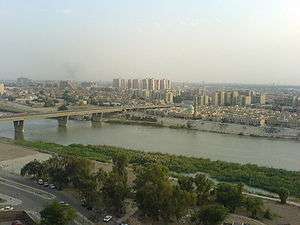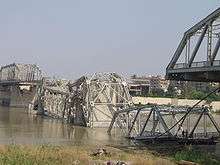Damage to Baghdad during the Iraq War
The city of Baghdad suffered significant damage during the Iraq War.
In October 2003, a joint United Nations/World Bank team conducted an assessment of funding needs for reconstruction in Iraq during the period 2004-2007.[2] A similar study conducted by the Central Bureau of Statistics Iraqi cooperation with the United Nations and is based on surveys conducted in 2004 that 1/3 of Iraqis live in poverty, in spite of the rich natural resources of the country.[3]
Al-Askari Mosque

The Al-Askari Mosque was bombed twice, over two years.
On February 22, 2006, at 6:55 a.m. local time (0355 UTC) explosions occurred at the mosque, effectively destroying its golden dome and severely damaging the mosque. Several men belonging to Iraqi Sunni insurgent groups affiliated with Al-Qaida, one wearing a military uniform, had earlier entered the mosque, tied up the guards there and set explosives, resulting in the blast. Two bombs were set off[4][5] by five[6] to seven[7] men dressed as personnel of the Iraqi Special forces[8] who entered the shrine during the morning.[9]
At around 8 a.m. on 13 June 2007, operatives belonging to al-Qaeda destroyed the two remaining 36 m (118 ft)-high golden minarets flanking the dome's ruins. No fatalities were reported. Iraqi police have reported hearing "two nearly simultaneous explosions coming from inside the mosque compound at around 8 a.m."[10] A report from state run Iraqiya Television stated that "local officials said that two mortar rounds were fired at the two minarets."[10]
As of April 2009, the golden dome and the minarets have been restored and the shrine reopened to visitors.[11]
Electricity
During the Gulf War of 1991 aerial bombardment caused severe damage to the electric grid that operated the pumping stations and other facilities for potable water delivery and sewage treatment. The sanctions imposed by the UN at the conclusion of the Gulf War exacerbated these problems by banning the importation of spare parts for equipment and chemicals, such as chlorine, needed for disinfection.
The invasion of Iraq produced further degradation of Iraq’s water supply, sewerage and electrical supply systems. Treatment plants, pumping stations and generating stations were stripped of their equipment, supplies and electrical wiring by looters. The once-capable cadre of engineers and operating technicians were scattered or left the country. Reconstruction efforts faced a nation with a severely degraded infrastructure.
In the hot summer of 2004, electricity was only available intermittently in most areas of the city. According to a member of Paul Bremer's staff, the problems with electricity were exacerbated by a surge in the use of air conditioners which were previously banned by Saddam Hussein.
Baghdad continues to suffer regular rolling power outages.
Baghdad Zoo
Within eight days following the 2003 invasion, only 35 of the 700 animals in the Baghdad Zoo survived. This was a result of theft of some animals for human food, and starvation of caged animals that had no food or water.[12] Survivors included larger animals like lions, tigers, and bears.[12] Notwithstanding the chaos brought by the invasion, South African Lawrence Anthony and some of the zoo keepers cared for the animals and fed the carnivores with donkeys they had bought locally.[12][13]
Transportation
Traffic problems in Baghdad have increased significantly since the 2003 invasion, credited to the formation of the Green Zone blocking roads, and new laws about automobile ownership.[14] The Baghdad Metro completely stopped service until October 2008.[14]
Bridges
Three of Baghdad's 13 bridges over the Tigris river have been targeted by large explosions.[15][16] The Al-Sarafiya bridge bridge was destroyed when an abandoned truck bomb exploded on April 12, 2007.[17] At least 10 people were killed and 26 injured, though there were reports of 20 more trapped in cars that had gone off the bridge.[18]
Sanitation

Before the invasion there were 1200 working waste collection trucks. Most of the vehicles were destroyed or lost in the looting that seized the capital after the American invasion. The deputy mayor of Baghdad estimates the city needs 1,500 waste collection vehicles.[19]

National Museum of Iraq
At the National Museum of Iraq, which had been a virtual repository of treasures from the ancient Mesopotamian cultures as well as early Islamic culture, many of the 170,000 irreplaceable artifacts were either stolen or broken (partially found safe and well later). On April 14, The Iraq National Library and National Archives were burned down, destroying thousands of manuscripts from civilizations dating back as far as 7,000 years.[20]
Looting
As the American forces secured control of the capital, Iraqi civilians immediately began looting the palaces, as well as government offices. At the important Yarmuk Hospital, not only all beds, but absolutely all its medical equipment, both large and small, was stolen. One other hospital managed to keep on functioning in a manner by organizing local civilians as armed guards.
Serious looting was described at National Museum of Iraq, and the Saddam Arts Center, the University of Baghdad, three five-star hotels: the Al Rasheed Hotel, the Al-Mansour and Babel Hotel, state-owned supermarkets, many embassies, and state-owned factories.[21]
Curfew
A nighttime curfew was imposed on the city immediately after the invasion. It was re-imposed for a whole weekend curfew during 2006,[22] and for one night during the 2010 Iraq election.[23]
Buildings Damaged
- St. George’s Anglican Church[24]
- The 2003 Jordanian embassy bombing in Baghdad was the detonation of a truck bomb outside of the Jordanian embassy in Iraq on August 7, 2003.
- Destruction of the Canal Hotel, the location of the UN in Baghdad.
Undamaged
According to globalsecurity.org, the Republican Palace (Iraq) and the Al Sijoud Palace were both reported damaged but unharmed.[25]
See also
References
- ↑ Estimates of total population differ substantially. The Encyclopædia Britannica gives a 2001 population of 4,950,000, the 2006 Lancet Report states a population of 6,554,126 in 2004.
- "Baghdad." Encyclopædia Britannica. 2006. Encyclopædia Britannica Online. 13 November 2006.
- ""Mortality after the 2003 invasion of Iraq: a cross-sectional cluster sample survey"" (PDF). (242 KiB). By Gilbert Burnham, Riyadh Lafta, Shannon Doocy, and Les Roberts. The Lancet, October 11, 2006
- Baghdad from GlobalSecurity.org
- ↑ UN/World Bank Joint Iraq Needs Assessment October 2003
- ↑ [chrome://browser/content/browser.xul "ثلث سكان العراق فقراء وسياسات اقتصاد السوق الحر تفاقم مستوى الحرمان"] Check
|url=value (help). Retrieved 2010-04-26. - ↑ "Explosion destroys Shiite shrine golden dome". Ireland On-Line. Retrieved February 23, 2006.
- ↑ "Bombers strike Shia mausoleum in Iraq". IBN Live. Retrieved February 23, 2006.
- ↑ Knickmeyer, Ellen (2006-02-23). "Bombing Shatters Mosque In Iraq". WashingtonPost.com. Retrieved February 23, 2006.
- ↑ "Blast destroys golden dome of Iraq's shrine". HindustanTimes.com. Retrieved February 23, 2006.
- ↑ Knight, Sam (2006-02-22). "Bombing of Shia shrine sparks wave of retaliation". TimesOnline.com. London. Retrieved February 23, 2006.
- ↑ "Iraqi shrine bombing spurs wave of sectarian reprisals". CBC News. 2006-02-22. Retrieved February 23, 2006.
- 1 2 Graham Bowley (2007-06-13). "Minarets on Shiite Shrine in Iraq Destroyed in Attack". New York Times.
- ↑ Bombed Iraq shrine reopens to visitors Archived 2009-05-19 at WebCite
- 1 2 3 "The Choice, featuring Lawrence Anthony". BBC radio 4. 2007-09-04. Retrieved 2007-09-04.
- ↑ Anthony, Lawrence; Spence Grayham (2007-06-03). Babylon's Ark; The Incredible Wartime Rescue of the Baghdad Zoo. Thomas Dunne Books. ISBN 0-312-35832-6.
- 1 2 "Baghdad Metro - The Digital Journalist". Retrieved 2010-04-26.
- ↑ "Insurgents target Baghdad bridges". Retrieved 2010-04-23.
Three of Baghdad's 13 bridges over the Tigris river have been targeted by large explosions
- ↑ "ReliefWeb » Document » Iraqis fear "bridge wars" is plot to divide Baghdad". Retrieved 2010-04-23.
- ↑ "Explosion targets Baghdad bridge". BBC News. 2007-04-12. Retrieved 2007-08-02.
- ↑ "Suicide truck bomb collapses Baghdad bridge". MSNBC. 2007-04-12. Retrieved 2007-08-02.
- ↑ NYTimes 10/11/06
- ↑ Eskander, Saad. "The Tale of Iraq's 'Cemetery of Books' " (cover story), in: Information Today; Dec 2004, Vol. 21, issue 11, p. 1-54; 5 pl, 1 color
- ↑ Collier, Robert (2003-04-12). "Looters shake Iraqi cities / CHAOS: Troops watch as Baghdad is ransacked - SFGate". The San Francisco Chronicle. Retrieved 2010-04-10.
- ↑ "Total curfew in force in Baghdad". BBC. Saturday, 30 September 2006, 19:39 GMT 20:39 UK. Retrieved 2010-04-26. Check date values in:
|date=(help) - ↑ "Vote count begins in Iraq election". Al Jazeera. Retrieved 2010-04-26.
- ↑ "Church Times - Baghdad church damaged". Retrieved 2010-04-23.
- ↑ Pike, John. "Iraqi Leadership Targets - Bomb Damage Assessment, Baghdad, Iraq". GlobalSecurity.org. Retrieved 2010-04-26.
The Republican Palace

.jpg)